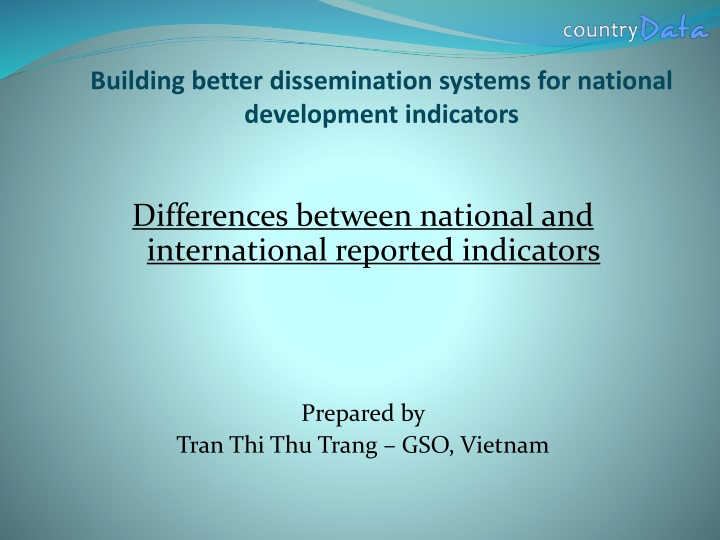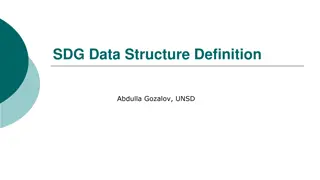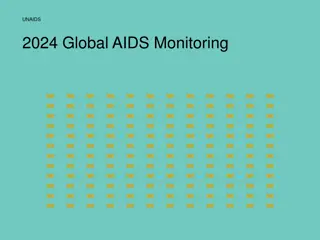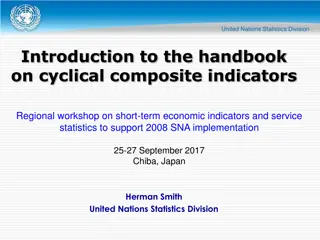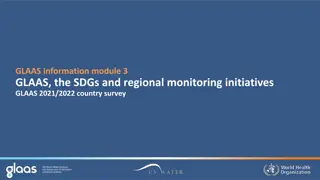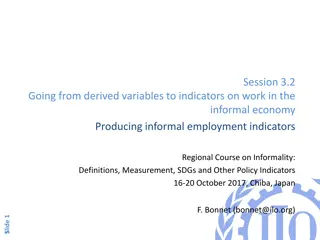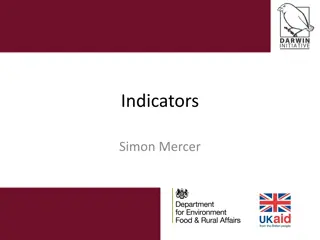National Development Indicators: Differences and Solutions
Explore the challenges in disseminating national development indicators compared to international reports, focusing on key indicators like internet users, maternal mortality ratio, employment rates, child underweight, and malaria cases. Understand reasons for discrepancies and learn ways to address them effectively.
Download Presentation

Please find below an Image/Link to download the presentation.
The content on the website is provided AS IS for your information and personal use only. It may not be sold, licensed, or shared on other websites without obtaining consent from the author.If you encounter any issues during the download, it is possible that the publisher has removed the file from their server.
You are allowed to download the files provided on this website for personal or commercial use, subject to the condition that they are used lawfully. All files are the property of their respective owners.
The content on the website is provided AS IS for your information and personal use only. It may not be sold, licensed, or shared on other websites without obtaining consent from the author.
E N D
Presentation Transcript
Building better dissemination systems for national development indicators Differences between national and international reported indicators Prepared by Tran Thi Thu Trang GSO, Vietnam
Content 5 indicators need to be explained Reasons for differences How to solve
5 indicators need to be explained 1. Internet users 2. Maternal mortality ratio 3. Employment-to-population ratio 4. Children moderately or severely underweight 5. Notified cases of malaria
1. Internet users (per 100 population) Before adjustment
Internet users (Count.) 1. Definition Internet users is the number of users of internet. The Internet is a linked global network of computers in which users at one computer, if they have permission, get information from othercomputers in the network. 2. Method of computation The total number of Internet users is divided by population and multiplied by 100. 3. Data collection In VietNam where Internet user surveys are not available, the ITU uses average multipliers to estimate the numberof users persubscriber.
Why different? At first we calculate this indicator using the unit is number of subscribers. After our review unit has changed unit by using the unit is number of user and the result is to change data. We have editted data of this indicatoron Countrydata. The data can also be misleading because of multiple prepaid Internet accounts, free Internet access accounts or public Internet access such as Internet cafes. Besides, in the modern time, internet access is not necessary done by computers but mobile as well, thus, this indicator is not fully covered.
Internet users (Per 100 population) After adjustment
Maternal mortality ratio (Count.) 1. Definition The maternal mortality ratio is the number of women who die from any cause related to or aggravated by pregnancy or its management (excluding accidental or incidental causes) during pregnancy and childbirth or within 42 days of termination of pregnancy. 2. Method of computation It can be calculated by dividing recorded (or estimated) maternal deaths by total recorded (or estimated) live births in the same period and multiplying by 100,000. It also can be calculated directly from data collected through vital statistics registrations, household surveys or hospital studies.
Why different? Official data are usually obtained from health service records, but few women in rural areas have access to health services. Available data on levels of maternal mortality are generally significantly underestimated problems of misclassification and under-reporting of maternal deaths. The difficulty in distinguishing deaths that are genuinely related to pregnancy from deaths that are not The WHO, the UNCEF, the UNFPA have adjusted existing data to take account of these problems and have developed model-based estimates for countries with no reliable national data on maternal mortality. It is these estimates that are usually published in international tables. because of
3. Employment to population ratio (Count.) 1. Definition Employment to population ratio is the percentage of total employed workers with total population. Employed population (working) includes persons aged 15 and over in the reference period (one week) 2. Method of computation Formula: Employment topopulation ratio = Numberof employed workers/Total population x 100 Whydifferent? The same definition and method, it may be different data source which in Vietnam this indicator was calculated based on database of Population and Housing Census every 10 year and Sample survey on labor employment every year.
4. Children moderately or severely underweight (percent) UNSD Prevalence of underweight children under-five years of age-Vietnam
Prevalence of underweight children under-five years of age-Vietnam 1. Definition It is the percentage of children under age 5 whose weight for age is less than minus two standard deviation below the median. 2. Method of computation Children whose weight for age is less than minus two SD of the median weight of NCHS reference population is considered malnourished Formula Number of children under 5 whose weight is less than M-2SD of the region in the survey time point Prevalence of underweight children under-five years of age = x 100 Total children under age 5 that were weighted at the same time
Why different? Data is calculated based on weight not tall Data on this indicator are disseminated via: report on Annual National Nutrition Survey, National Nutrition Institute; Report on Household living standard survey and international report estimates based on orther source.
Notified cases of malaria (per 100 000 population) No difference
How to solve Standardized metadata on national report Consensus on definitions and calculation methods, data source between national and international metadata Indicators are specific for Vietnam s condition, UNSD needs to expand DSD can be mapped Introducing about this project on http://www.gso.gov.vn/ItemPreview.aspx?ItemID=14920
THANK YOU FOR YOUR ATTENTION
